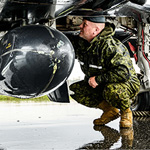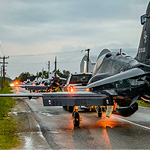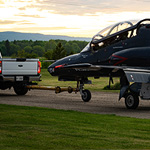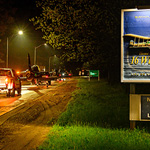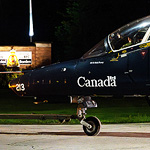A New Life for the CT-155 Hawk
May 24, 2024 - Defence Stories
RCAF re-investing aircraft as maintenance trainers
2 CAD Public Affairs
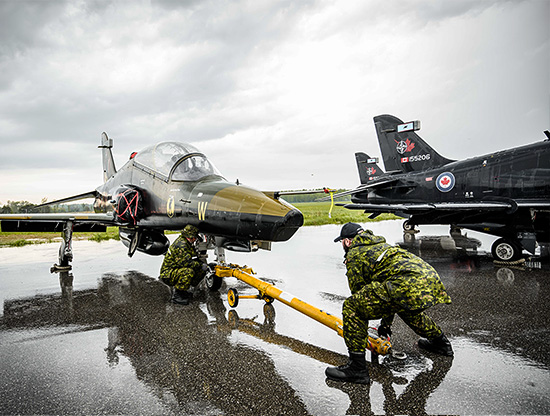
Caption
A CT-155 Hawk is prepared for road move to 16 Wing/CFB Borden at the Collingwood, Ontario airport.
The CT-155 Hawk, formerly the RCAF’s Fighter Lead-in advanced jet training aircraft, is finding new life at the Canadian Forces School of Aerospace Technology and Engineering, where a fleet of 15 aircraft will soon serve as new maintenance trainers for aircraft technicians-in-training.
The Hawks were taken out of flying service in March 2024 following close to 24 years training Canadian, allied and partner nation pilots on the fundamentals of fighter jet tactics. With the aircraft no longer meeting the needs of in-air training for fifth-generation fighters like the RCAF’s future CF-35A, the decision was made to cease in-air training with the jets while options for a more suitable future fighter lead-in trainer are explored. In the meantime, fighter pilots continue to be trained in places like the Euro-NATO Joint Jet Pilot Training program at Sheppard Air Force Base, Texas and the Italian Air Force’s International Flight Training School at Decimomannu Air Base, Italy.
“While the CT-155 no longer meets the Air Force’s needs for fighter jet flying training related to the coming CF-35, that does not mean the jets are not still relevant for training on the ground— in this case we are re-investing them as trainers for our newest aircraft technicians,” said Colonel Adam Carlson, Director of RCAF Training. “Although the CT-155 Hawk was designed in the 70’s, Canada’s upgraded Hawks represent a more modern design than the current maintenance trainer; the CT-114 Tutor aircraft. The Tutor maintenance trainers, after several decades of stalwart use, are showing their age, while also lacking system complexity and overall relevancy to modern aircraft that our technicians will eventually be working on after their graduation.”
The addition of the Hawks to CFSATE represents another step in the RCAF’s nascent Training Modernization Strategy, which, amongst several initiatives, promotes the use of enhanced learning aids across the Air Force to prepare members for operations in an aerospace domain that is seeing rapid advances in technology. This additional complexity will prove instrumental in supporting the digital literacy of aircraft technicians leading to greater adaptability and agility in meeting RCAF readiness.
“As an airframe, the Hawks have many components that are still representative of newer aircraft including modern landing gear, wing structures and digital avionics like Head-up-Displays and mission computers which help instructors teach students how to maintain the RCAF’s current and future fleets,” said LCol Ismael Koussay, Commandant of CFSATE. “Because of the Hawk’s design, which has easy accessibility to several key systems— including the engines— we anticipate an enhanced learning environment for our future Air Force technicians.”
Upon 419 Tactical Fighter Training Squadron entering a period of hiatus in early March, ten Hawks were flown from Cold Lake and Moose Jaw to the Collingwood, Ontario airport. So far, these aircraft have been towed 40 kilometers in the evenings of 13/14 and 14/15 May to Borden where they will be modified to teach RCAF technicians. Three more Hawks will be flown to Collingwood over the coming weeks, while two additional airframes and parts will be taken by truck from Moose Jaw to Borden.
“As we chart the course for the RCAF’s modernization efforts, it’s imperative to prioritize the enhancement of our training infrastructure, not only for aircrew with Future Aircrew Training (FAcT), but throughout the entire training system for the RCAF. The Hawk represents an essential asset in this endeavour, offering a dynamic platform tailored to meet the evolving demands of technician training,” said Colonel Mario Charron, Director of the RCAF’s Air Simulation and Training. “Compared to the Tutor, the Hawk equips our personnel with the proficiency and confidence needed to navigate the complexities of modern aircraft systems. By harnessing the power of a contemporary training platform, we are not just preparing technicians; we are cultivating a generation of adaptable and forward-thinking aviation professionals, ready to ensure the operational readiness of the Air Force well into the future.”
With 2024 marking the RCAF Centennial, the new role for the CT-155 at Borden, the birthplace of Canada’s Air Force, marks a fitting continuation of service for the Hawk fleet, enabling air operations into the next century.
“As the RCAF is undergoing a period of modernization not seen since the Second World War, recapitalization of training aids, including maintenance trainers, is a critical part to our future success as an Air Force, “said Colonel Gabriel Doré, Commander of 16 Wing Borden. “The Air Force sees training as a capability in and of itself and the arrival of the Hawks at CFSATE speaks to the importance of realistic and relevant instruction as a keystone for effective aerospace operations.”
